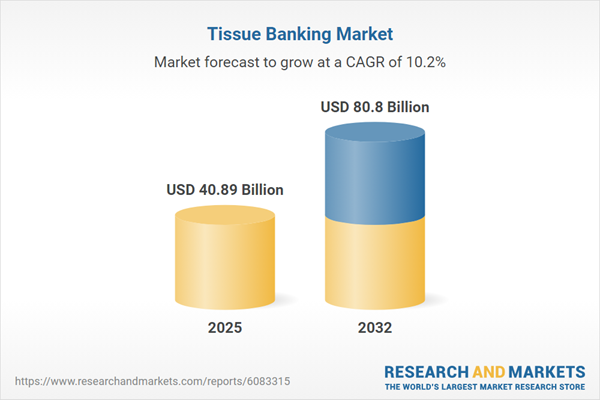Speak directly to the analyst to clarify any post sales queries you may have.
Senior executives navigating the regenerative medicine space must respond to the dynamic landscape of the tissue banking market. Shaped by innovation, regulatory change, and evolving clinical demands, this environment requires strategic oversight for sustainable growth and resilience.
Market Snapshot: Tissue Banking Market Size and Trends
The tissue banking market advanced from USD 37.13 billion in 2024 to USD 40.89 billion in 2025, maintaining a steady CAGR of 10.20%. By 2032, it is projected to reach USD 80.80 billion. Growth within this sector reflects a convergence of rapid technological advances, evolving regulatory landscapes, and clinical priorities. Companies are implementing advanced preservation and processing to support graft viability, while investing in modern facilities drives expansion and efficiency. Early adopters of digital tracking and enhanced processing methods are positioned to capitalize on these trends as global demand intensifies.
Tissue Banking Market: Scope & Segmentation
- Tissue Types: The market serves allografts (bone, cartilage, skin, tendon), autografts (blood, bone, skin), and xenografts (from bovine and porcine origins), supporting a broad spectrum of therapeutic needs across surgeries and reconstructive medicine.
- Preservation Methods: Key approaches include cryopreservation, freeze drying, and fresh storage, each designed to optimize shelf-life and maintain clinical applicability for different graft types.
- Tissue Sources: Organizations utilize animal-derived, human-based, and synthetic graft materials, enabling flexibility for donor sourcing and aligning with varying ethical requirements.
- Applications: Tissues are vital for cardiovascular and dental procedures, ophthalmology (corneal and retinal repair), orthopedics (joint reconstruction, spinal fusion, trauma), and plastic surgery—reflecting the sector’s versatility across medical disciplines.
- End Users: The ecosystem includes ambulatory surgical centers, hospitals, research institutes, and dedicated tissue banks, each demanding specialized procurement practices and clinical processing standards.
- Regions: Activities span the Americas (North America and Latin America), Europe, Middle East & Africa, and Asia-Pacific, with each region presenting distinct regulatory frameworks and healthcare priorities that influence adoption rates and partnership models.
- Key Companies: Prominent organizations such as MTF Biologics, CryoLife, RTI Surgical, AlloSource, PerkinElmer, Cryoport, BioLife Solutions, Cryo-Cell International, Cordlife Group, and CorneaGen are active across the value chain, supporting both innovation and compliance.
Tissue Banking Market: Key Takeaways for Decision-Makers
- Regulatory frameworks are prompting the industry to introduce advanced storage protocols and strengthen quality assurance, providing a platform for organizations that prioritize compliance.
- Digital technologies, including blockchain and automated monitoring, are improving traceability and supply chain integrity across tissue banking operations.
- Innovations in bioreactor cultivation and three-dimensional bioprinting are facilitating personalized graft solutions and supporting expanded application in clinical settings.
- Emerging markets drive swift adoption rates, propelled by governmental strategies and development initiatives aimed at regenerative medicine infrastructure.
- Strategic partnerships, such as joint ventures and research collaborations, accelerate the pathway from laboratory innovation to clinical implementation, closing the R&D-to-market gap.
Tariff Impact on Tissue Banking Supply Chains
Recent tariff adjustments in the United States have increased operational costs and placed new emphasis on domestic sourcing for graft materials. In response, market players are diversifying suppliers, investing in in-country processing, and implementing adaptable inventory strategies. These measures collectively reduce supply chain vulnerabilities and help maintain graft availability for critical interventions, ensuring business continuity in a shifting policy environment.
Methodology & Data Sources
This analysis integrates primary research via in-depth interviews with executives, clinicians, and regulators, backed by facility visits. Secondary research encompasses peer-reviewed studies, industry documentation, and regulatory resources, combining quantitative benchmarks with qualitative expert perspectives for comprehensive, reliable insights.
Why This Report Matters
- Enables senior leaders to develop targeted market entry and segmentation strategies tailored to both global and regional initiatives.
- Clarifies how regulatory evolution and advanced technology adoption impact investment and partnership options across the tissue banking landscape.
- Delivers best practice guidelines and benchmark data to support alignment with new compliance and operational standards.
Conclusion
Portfolio alignment, digital innovation, and cross-sector partnerships are redefining the tissue banking market. This report delivers foresight and actionable guidance for leaders focused on sustainable growth in regenerative medicine.
Table of Contents
3. Executive Summary
4. Market Overview
7. Cumulative Impact of Artificial Intelligence 2025
Companies Mentioned
The companies profiled in this Tissue Banking market report include:- MTF Biologics
- CryoLife, Inc.
- RTI Surgical, Inc.
- AlloSource
- PerkinElmer, Inc.
- Cryoport, Inc.
- BioLife Solutions, Inc.
- Cryo-Cell International, Inc.
- Cordlife Group Limited
- CorneaGen, Inc.
Table Information
| Report Attribute | Details |
|---|---|
| No. of Pages | 187 |
| Published | October 2025 |
| Forecast Period | 2025 - 2032 |
| Estimated Market Value ( USD | $ 40.89 Billion |
| Forecasted Market Value ( USD | $ 80.8 Billion |
| Compound Annual Growth Rate | 10.2% |
| Regions Covered | Global |
| No. of Companies Mentioned | 11 |









